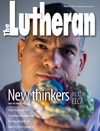 If you haven’t yet, please go pickup a copy of this month’s The Lutheran. Inside, my seminary advisor is highlighted as one of the new thinkers in the ELCA and my home congregation’s approach on the issue of gay marriage is spread over several pages (sadly, it is only partially online). The picture of the two members in the church basement is a great one. Trinity Long Island City is really starting to shine.
If you haven’t yet, please go pickup a copy of this month’s The Lutheran. Inside, my seminary advisor is highlighted as one of the new thinkers in the ELCA and my home congregation’s approach on the issue of gay marriage is spread over several pages (sadly, it is only partially online). The picture of the two members in the church basement is a great one. Trinity Long Island City is really starting to shine.
I actually like the article quite a bit but it lacks a little…something. I felt like it didn’t tell the complete story and that there is a history that is lost in the article. And that’s not the author’s fault, actually. Most of the people quoted in the article, including the Pastor, have not been at Trinity for very long. And the story of the long-time member isn’t fleshed out. I’ve only been attending and a member of Trinity going on 6.5 years now – but I’ve had the opportunity to see the upheaval and reflection that a transition in pastoral leadership brings. And that upheaval, I think, plays an important point of Trinity’s story. Because what the article doesn’t realize is that a lot of the “conservative” folks have already left. They left not because of social issues – they left because of pastoral leadership change. And that, well, happens all the time and actually shifts the kind of conversation that needs to be had. It isn’t a defensive traditional view that must be approached. Rather, the traditionalists who have stayed are the ones who, in my experience and through what I’ve witnessed, actually modeled a welcome and openness that has allowed this issue to be engaged in. Without them, I think, there wouldn’t be any gays and lesbians in the congregation – they never would have come. And I don’t think many of the young people, including me, would have stayed either.
That’s the funny thing, really. Even Mary, with her so-called traditional view, can’t really be considered a “conservative” person. And, by conservative, I mean congregationally conservative. I don’t even know if that’s a real phrase – but, to me, congregationally conservative means a person or congregation who has its walls up and does not allow new people through the doors and into positions of authority. The welcome and love is, well, hard to see fully. Mary, from my experience, and from my witness, is not that way. In fact, she describes the congregation – a congregation that continues to get younger, socially liberal, and more vibrant every week, as such a happier and more lovely place than when it was in the 1950s and 60s. And she’s part of the welcome that has made that happened. Her and the entire cadre of older women and men who make up the decades-old-core of Trinity, were the ones who gave witnessed a welcome towards anyone at the church, regardless of sexual orientation, race, age, or class, that infects anyone who comes into the doors. It wasn’t/isn’t always easy, and I’m not saying mistakes, biases, gossip, and judgements, wouldn’t show up. But they are a group of folks who welcome others easily and support the raising up of all people into various positions of authority within the church. It’s brilliant.
I know I’m incredibly biased when it comes to this issue because I consider these folks my friends and always felt incredibly welcomed by them. And I’ve seen them welcome gays and lesbians as well. They’ve struggled with the issue. They’ve acknowledge that it’s a generational issue. They also know that it’s an issue tied into not knowing, truly knowing, the lives of gays and lesbians within their midst. But as they welcomed and truly engaged with GLBTs, they changed. They’ve grown. They’re different than they use to be. It’s not just teaching – but it’s a knowing and engaging that has changed them. And this, I think, stems from their own evangelism and welcome to whoever walked through the doors or lived in the surrounding community.
I hope the congregation does, eventually, fully embrace same-sex weddings in the sanctuary. I think they will and I think that some of the old guard will struggle with it. Some might never truly come around and tensions might rise. But the old guard, the traditionalists, were the ones that, I think, helped model a welcome that first welcomed all of new folks into the doors. And, as we were welcomed, we learned, organically, to welcome others by taking stock of anyone who showed up for the first time and inviting them to brunch with us, sometimes even before we knew their name. The welcome of Christ lived out in the welcome of the other. That’s a model of ministry that I don’t always see all the time – but one that I would like to practice more and inspire those within my ministry reach to practice, if not everyday, than at least on Sunday mornings.
